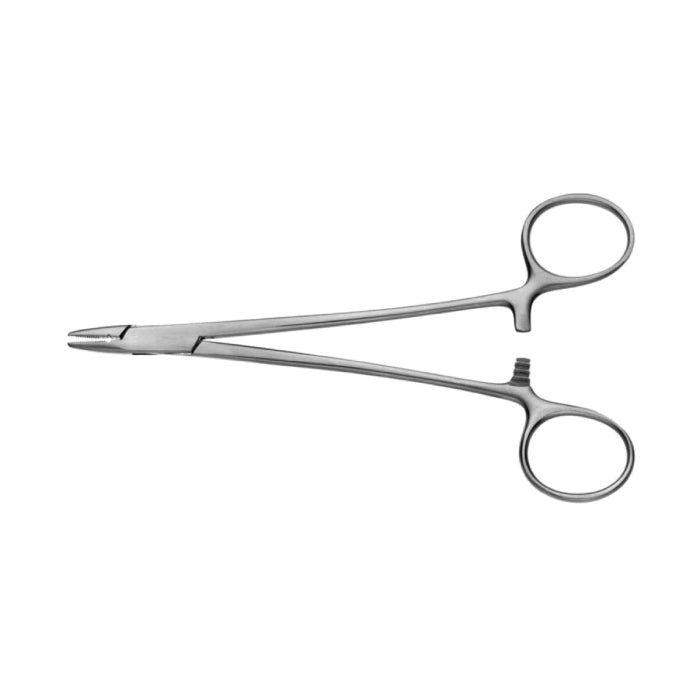
Needle Holder Surgical Instrument
Choose options
Product description
Features:
- Serrated Jaws with a LongitudinalGroove for Secure Grip
- The jaws' edges are blunt and slender,allowing for atraumatic and accurate manoeuvring.
- Long and slender body for deepsurgical access
- Large Ratcheted Finger Ring Handlesfor Easy And Quick Manipulation
| Product | Needle Holder |
| Handle Type | Ring Handle |
| Joint Type | Box Joint |
| Ratchet / Lock | Yes |
| Overall Length | 6, 8 inches |
| Finish | Satin |
| Material | Metal |
| Quality | Premium |
| Reusable | Yes |
Needle Holder Surgical Instrument FAQ
Q: What is a Needle Holder used for?
A: A Needle Holder is a surgical instrument designed for securely holding and manipulating needles during suturing or stitching of surgical wounds. It provides a firm grip on the needle, allowing surgeons to suture with precision and control.
Q: What are the features of a Needle Holder?
A: Needle Holders come with various features to facilitate suturing procedures. These include:
Serrated Jaws with a Longitudinal Groove: The jaws of the instrument have serrations and a groove that provide a secure grip on the needle, preventing slippage during suturing.
Atraumatic and Accurate Maneuvering: The jaws' edges are blunt and slender, allowing for gentle and precise handling of the needle, minimizing tissue damage.
Long and Slender Body: The instrument has a long and slender body, enabling deep access to surgical sites.
Ratcheted Finger Ring Handles: The instrument features large finger ring handles with a ratchet clamp, allowing for easy and quick manipulation while maintaining a secure hold on the needle.
Q: What is the size range of Needle Holders?
A: Needle Holders are available in different sizes to accommodate various surgical needs. The commonly used sizes are 6 inches and 8 inches. The size selection depends on the surgeon's preference and the requirements of the specific procedure.
Q: Are the Needle Holder jaws adjustable?
A: No, the Needle Holder jaws are not adjustable. They are designed to provide a secure and non-slip grip on the needle throughout the suturing process.
Q: What is the material used in Needle Holders?
A: Needle Holders are typically made of high-quality stainless steel. Stainless steel is widely used in surgical instruments due to its durability, corrosion resistance, and compatibility with sterilization processes.
Q: Can Needle Holders be reused?
A: Yes, Needle Holders are reusable instruments. They are designed to withstand sterilization processes, allowing for multiple uses with proper cleaning and sterilization between each use. It is important to follow the manufacturer's guidelines and local healthcare regulations for sterilization practices.
Q: Can Needle Holders accommodate different types of needles?
A: Yes, Needle Holders are versatile instruments that can accommodate a wide range of suture needles, including both absorbable and non-absorbable types. The inner cross-serrations on the jaws provide a secure grip on various needle sizes and shapes.
Q: Are Needle Holders suitable for all surgical procedures?
A: Needle Holders are commonly used in various surgical procedures that involve suturing or stitching, such as general surgery, orthopedic surgery, and plastic surgery. However, the suitability of a Needle Holder for a specific procedure may depend on the surgeon's preference, the type of needle being used, and the nature of the surgical site. Surgeons often have different preferences for specific procedures, and they may choose different types of Needle Holders based on their experience and comfort.
Q: Can Needle Holders be used in non-surgical settings?
A: Needle Holders are specifically designed for surgical use in sterile environments. They are not intended for non-surgical or non-medical applications. It is important to use Needle Holders only under the supervision of trained healthcare professionals in appropriate clinical settings.
Q: How should Needle Holders be cleaned and sterilized?
A: Proper cleaning and sterilization of Needle Holders are crucial to ensure infection control and patient safety. After each use, the instrument should be thoroughly cleaned using an appropriate medical-grade disinfectant or detergent to remove any organic debris. It should then be sterilized using standard sterilization methods, such as autoclaving or chemical sterilization, following the manufacturer's instructions. Proper maintenance and adherence to sterilization protocols are essential for the longevity and
Country of Origin : India
Manufacturer/Importer/Marketed By : Meddey Technologies Pvt Ltd.C-75, First Floor DDA Sheds,Industrial Area , Phase 1 , Okhla , New Delhi - 110020 , Phone No- +91 8586-012345
